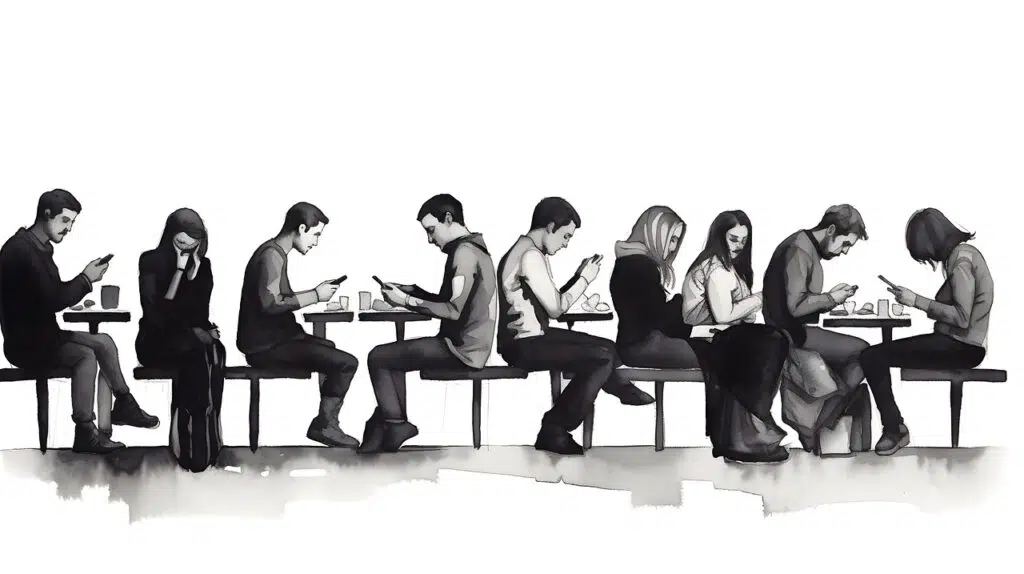
In our increasingly connected world doomscrolling has become a common struggle. Social media and other digital platforms offer incredible opportunities for connection, information, and entertainment yet, they also present unique challenges to our mental well-being. Have you ever picked up your phone for a quick check, only to look up 45 minutes later wondering where the time went, perhaps even feeling a sense of shame or unease? You’re not alone. This experience, often leading to what we know as ‘doomscrolling‘ and comparison, is a common struggle in the digital age. It’s hard to stop doomscrolling when the negative news cycle feels endless, but doing so is crucial for your mental health. Worse, this behavior can lead to a clinically significant increase in anxiety and depression risk.
At Hope For The Journey, we understand that navigating this digital landscape can be complex. Let’s explore what’s truly happening when we find ourselves lost in endless feeds and how we can implement thoughtful strategies for a healthier digital life.
Understanding Doomscrolling: More Than Just a Bad Habit
While it might feel like a simple bad habit, doomscrolling often taps into a deeper mechanism within our nervous system. When we are stuck in a ‘fight, flight, or freeze’ response, our brain is constantly scanning for danger, even in the online realm. This continuous doomscrolling through distressing news or overwhelming information can become a survival pattern, where we feel compelled to consume everything, believing we need to be fully aware of all potential threats or significant events.
This endless search for information, fueled by a heightened state of alert, paradoxically leaves us feeling more anxious, not less. It’s a nervous system loop that can activate and overwhelm us, rather than provide the comfort or knowledge we seek.
The Comparison Trap: When Highlight Reels Dim Our Reality
Our brains are naturally wired for comparison, but social media amplifies this tendency to an extreme degree. What we see online are often ‘highlight reels’ – carefully curated, edited, and perfectly presented snippets of life. You might be seeing one polished photo out of dozens of attempts, or a perfectly worded update that took hours to craft. In essence, you’re looking at a highly filtered version of reality.
When you compare your own messy, authentic life—with its everyday challenges and unedited moments—to these meticulously constructed online personas, it creates a stark and often painful contrast. Even if your logical mind knows that what you see online isn’t the full picture, your nervous system doesn’t always make that distinction, and this is where doomscrolling can become a struggle. These habits can lead to increased feelings of inadequacy, self-doubt, and can significantly activate your nervous system, leaving you feeling worse, not better.
“Even if you’re like, ‘I really do like to just numb out for a little bit. Social media is just a way for me to kind of disconnect for a little bit.’ Watch out, because it actually may activate your nervous system in a negative way and might not be so helpful.”
This highlights a crucial point: what we perceive as ‘numbing out’ or disconnecting can actually have the opposite effect, leaving our nervous systems more agitated rather than soothed. It’s important to distinguish between healthy dissociation, which everyone experiences and can be helpful, and a trauma-driven urge to numb that inadvertently leads to nervous system activation.
Stop Doomscrolling: Creating Healthy Digital Boundaries and Promoting Digital Well-being
So, how can we put up ‘guardrails’ to protect our mental health in the digital age? It starts by breaking the habit of doomscrolling with intentionality and self-awareness.
Ask Yourself: What Do I Actually Need?
Before reaching for your phone, pause and check in with yourself. Are you looking for genuine rest, connection, or comfort? If you’re hoping for these things but consistently feel worse after scrolling, social media might not be the right tool for that need. Sometimes, what we truly need is a hug, a walk outdoors, a nap, or a moment of quiet reflection. Asking “What do I actually need right now?” can guide you toward more effective coping strategies that genuinely soothe your nervous system.
Practical Strategies for Mindful Internet Use:
- Set Timers: If you want to scroll, set a timer for a brief period (e.g., 10-15 minutes). When the timer goes off, log off.
- Unfollow Trigger Accounts: Curate your feed by unfollowing accounts that consistently make you feel anxious, inadequate, or distressed. Your online space should feel safe and supportive.
- Keep Your Phone Out of the Bedroom: Make your bedroom a screen-free sanctuary to improve sleep quality and reduce the temptation for late-night scrolling.
- Listen to Your Body: Pay attention to physical cues. A tight jaw, a sinking feeling in your chest, a headache, or an upset stomach can all be signals from your nervous system saying, “Enough is enough.” Listening to these signals is a powerful act of self-care and self-trust.
- Seek Deeper Support: If you find yourself consistently overwhelmed by digital interactions or struggling with trauma-driven scrolling, remember that support is available. You can learn more about how EMDR and trauma therapy can help process these underlying patterns.
Remember, these aren’t punishments; they are acts of self-care. They demonstrate that you value your well-being and are committed to limiting the nervous system activation that can stem from unbridled digital consumption.
Stop Doomscrolling: Choosing Self-Care Over Comparison
You are not weak for struggling with doomscrolling and the pull of digital platforms. You are human, living in a world designed to keep us hooked. Choosing to log off, to be intentional with your time, and to prioritize coming home to yourself more often than you scroll, is a profound act of self-compassion and self-preservation.
If you’re finding it difficult to implement these strategies or suspect that your digital habits are tied to deeper trauma responses, reaching out for professional support can make a significant difference. Our team at Hope For The Journey is here to help you navigate these challenges.
Let’s stay intentional, pay attention to what our bodies are telling us, and foster digital habits that truly support our mental health. For more insights on mental well-being, you can explore our full collection of blog posts. Thanks for being here, and we’ll see you next time.
